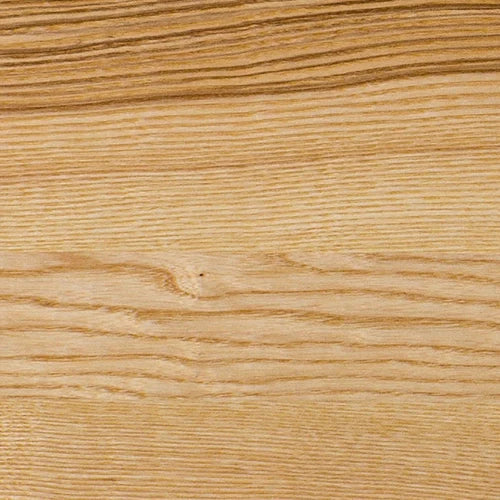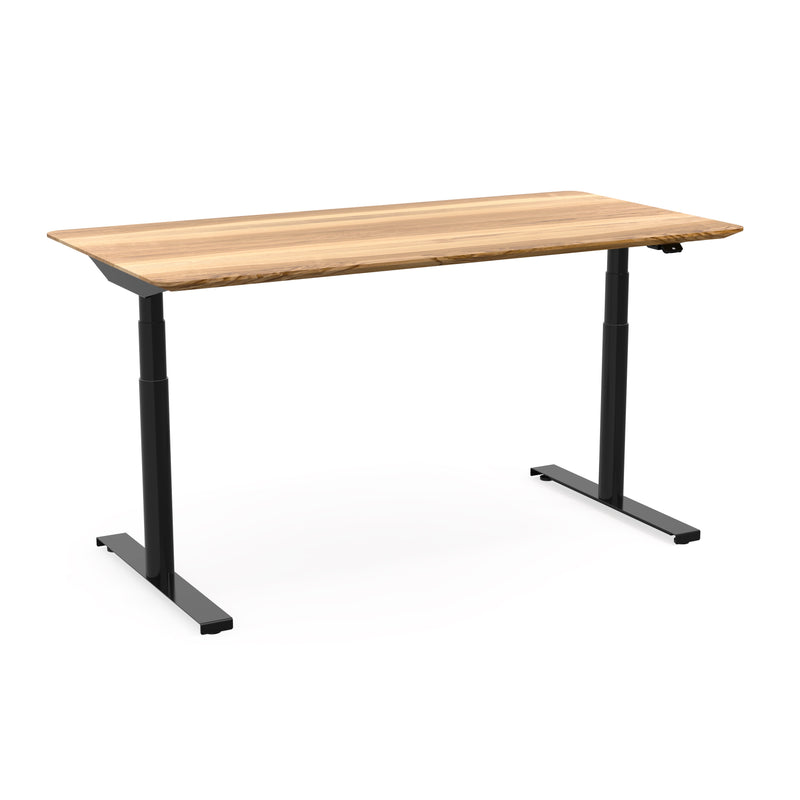Ash

Ash wood is an elastic, durable hardwood with a lively grain. It impresses with its high strength and good bending properties, making it ideal for furniture, interior design and dimensionally stable constructions. The light colour palette from creamy white to light yellow gives rooms a friendly, natural look.
What does ash wood look like?
Ash wood features a striking, vibrant grain with prominent growth rings and occasional small knots. In terms of color, ash ranges from nearly white to light yellow – depending on the origin and age of the wood.
Since ash is a natural material, no two pieces are alike. Especially with solid wood, the individual grain pattern gives each piece of furniture a unique appearance.
Compared to calmer woods like beech or maple, ash often has a more lively structure. Older ash trees develop a darker heartwood, which creates distinctive dark streaks in the timber.
How is ash wood treated?
Ash is typically oiled, lacquered, or white-pigmented oiled to emphasize its bright and friendly tone. Treatment with stains is also possible, although opaque stains can cover the natural grain.
Oiled surfaces remain breathable and can regulate moisture. Although they are somewhat more sensitive than lacquered surfaces, they can be easily re-oiled or repaired if needed. Natural furniture oil is an environmentally friendly and low-maintenance option.


Ecological footprint of ash wood
Ash wood is a renewable resource and considered one of the environmentally valuable materials for furniture and interior design. Its combination of stability, elasticity, and appealing aesthetics makes it especially versatile.
1. Sustainability of raw material sourcing
Ash trees primarily grow in Europe – including Germany, Poland, and the Baltic states. Sustainable forestry with FSC or PEFC certification ensures that timber harvesting remains in balance with natural forest regeneration.
2. Processing and energy consumption
Compared to synthetic materials or metals, processing ash wood requires relatively low energy. From felling to sawing, drying, and surface treatment, the energy footprint remains moderate. Proximity to the source also contributes to a positive energy balance.
Long transport distances can increase the CO₂ footprint even for ash. That’s why locally sourced ash wood is especially sustainable and supports the regional economy.


3. Durability
Ash wood is known for being very strong and highly elastic. These characteristics make it especially well-suited for furniture and applications subject to mechanical stress. With proper care, ash wood remains stable and beautiful for many years.
4. Reusability
Most ash wood is incinerated in biomass power plants via the recycling system and as bulky waste. Although the incineration is CO2-neutral – the ash tree has previously removed the CO2 from the atmosphere – and generates energy, what is more interesting from an ecological point of view is the good repairability of the material. In the furniture sector, in particular, damaged or worn ash can simply be glued, sanded or re-oiled to make it look like new again.
5. Biodegradability
Like all hardwoods, ash is fully biodegradable. It naturally decomposes and returns nutrients to the soil – without leaving behind toxins or microplastics.
Technical properties of ash wood
| Property | Value |
|---|---|
| Wood type | Hardwood |
| Density (raw) | 0.68 - 0.85 g/cm³ |
| Compressive strength | 45 - 55 N/mm² |
| Flexural strength | 100 - 110 N/mm² |
| Brinell hardness | 34 - 41 N/mm² |
| Modulus of elasticity | 11,000 - 13,000 N/mm² |
| Durability | Durable, but not weather-resistant |
| Weather resistance | Low – suitable for indoor use only |
| Color | Light yellow to creamy white, with reddish heartwood in older trees |
| Workability | Very good, easy to bend and shape |
| Uses | Furniture, sports equipment, tool handles, interior construction |
Ash wood at ekomia
Thanks to its friendly appearance and excellent mechanical properties, we use ash specifically for selected pieces in our furniture collection.
We exclusively use European ash wood from sustainable forestry, certified by FSC or PEFC.
All surfaces are treated with ecological, vegan furniture oil – allowing the wood to breathe and making it easy to care for or repair when needed.

Questions & answers for Ash
Here we answer some questions about Ash that are frequently asked by other users.
Do you still have any questions?
Do you have any questions or comments on this topic? Write a comment, we will be happy to answer.




